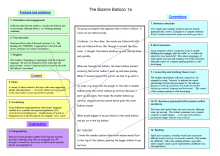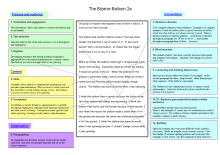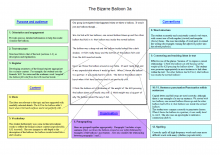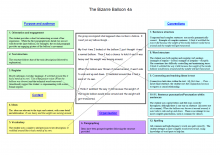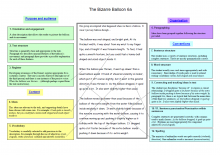Balloon throwing II
0
Overview
Using this Resource
Connecting to the Curriculum
Working with Students
Further Resources
This task is about describing and explaining the balloon-throwing investigation.
You need to write about what happened and then explain why you think it happened the way it did. Your POE sheet will help you do this.
Here is a title and a beginning for your writing:
The Bizarre Balloon
Our group investigated what happened when we threw a balloon.
It wasn't just any balloon though...
Task administration:
This task is completed online and does NOT have auto marking displayed to students.
Equipment:
- The students must have recently done the science activity Throwing balloons 3 or Throwing balloons 4 where they predict, observe, and explain what will happen when a balloon containing another balloon filled with water is thrown.
-
Then the students do this resource's writing task where they describe the balloon and what happens when it is thrown, and explain why they think it moved the way it did. Six annotated exemplars of student scripts (writing) are included under the Working with Students tab.
- The students should use their POE sheets from that activity to prompt their memories as they do this writing task. You may need to refresh the students’ memories of the science activity before they begin this task by discussing the science activity and the POE sheets.
Your judgement will determine to what extent you scaffold the task.
If you wish to increase the level of scaffolding, use the following suggestions (they give clarification and reminders about the writing side of the task but do not attempt to direct the students’ science thinking).
- Read the task to your students and encourage them to seek clarification from you whenever they need to.
- Explain that “bizarre” means “strange”, “unusual”.
- Read the introductory sentence of “The Bizarre Balloon” and explain that the beginning of the writing has been done for them to make it easier to start.
- Give verbal reminders - for example, “When you write about what happened when you threw the balloon, remember to get the order right. Tell what happened first, then … ". Remember what happened when _______ threw the balloon …”.
- Ask the students to do each section (1-3) together, one section at a time. This way, you can focus your reminders on one section only (unfortunately, this approach will mean they will not be able to work at their own pace).
Levels:
3, 4
Curriculum info:
Key Competencies:
Keywords:
Description of task:
Students first do the science activity Throwing balloons 3 or Throwing balloons 4 where they predict, observe, and explain what will happen when a balloon containing another balloon filled with water is thrown. Then the students do this resource's writing task where they describe the balloon and what happens when it is thrown, and explain why they think it moved the way it did. Six annotated exemplars of student scripts (writing) are included under the "Working with Students" tab.
Curriculum Links:
Literacy Learning Progressions (Writing)
The most relevant progressions are By the end of Year 4, By the end of Year 6, and By the end of Year 8.
Links to Science
This task models writing in support of the Science learning area. At levels 3 and 4 in science, students should be able to:
- describe in some detail what they notice
- use their science ideas to explain observations
- provide evidence to support their ideas
- build on others' ideas.
Learning Progression Frameworks
This resource can provide evidence of learning associated with within the Writing Learning Progressions Frameworks.
Read more about the Learning Progressions Frameworks.Diagnostic and formative information:
This task exemplifies how you might foreground "Using language, symbols, and texts" and, to a lesser extent, "Thinking" within writing through a focus on the way writers construct texts for particular purposes by the use of carefully chosen details. In this case the purpose is to describe and explain within a science context; therefore, the text details will include the grammatical structures and vocabulary specific to explaining and describing and, to some extent, to the science curriculum area.
Annotated exemplars
This resource was trialled by 56 students from Year 5-8 classes in decile 6-8 schools. The following student scripts were produced from the trial of the task. They have been assessed against 12 criteria which are explained in the Writing Assessment Guide, and annotated accordingly. The student scripts are first drafts.
This resource was trialled by 56 students from Year 5-8 classes in decile 6-8 schools. The following student scripts were produced from the trial of the task. They have been assessed against 12 criteria which are explained in the Writing Assessment Guide, and annotated accordingly. The student scripts are first drafts.
Next steps:
The following suggestions indicate possible next steps for working with students, based on the annotated student scripts produced from the trial of the task.
The Bizarre Balloon 1a
Spelling: Work with the student to brainstorm words that rhyme with "through" and discuss their meanings. Draw attention to those that end with the vowel digraph "ew" (for example blew, flew, few). Give the student a selection of sentences with the word "threw" or "through" blanked out, to complete and check. The student can then revisit and independently edit the Bizarre Balloon script.
The Bizarre Balloon 2a
Punctuation within sentences: Practise extending a simple sentence in a variety of ways by adding different dependent clauses to the beginning. For example, start with a sentence such as "I didn’t eat my breakfast." Add a variety of clauses to the beginning, using words such as "because", "after" or "when". For example, "Because we had run out of cornflakes, I didn’t each my breakfast" or "After I got up late, I didn’t eat my breakfast". Draw the student’s attention to the use of a comma to mark the end of the dependent clause. Ask the student to revisit and edit the Bizarre Balloon script, paying particular attention to the sentences in the second paragraph.
The Bizarre Balloon 3a
Paragraphing/Ideas: Ask the student to return to the writing and try to add more details and examples to each paragraph. For example, can they add an example to show how the balloon was "unpredictable", or why it was really hard to catch?
The Bizarre Balloon 4a
Sentence punctuation/Punctuation within sentences: Practise using commas to mark clauses in complex sentences. Give the student a simple sentence and support them to extend it by adding a variety of dependent clauses to the beginning (starting with words such as "although", "because", "when", or "after". Emphasise that a comma is used after the dependent clause. The student can then revisit and edit their writing.
The Bizarre Balloon 5a
Register: Provide a model of a simple scientific report (for example, a description of the results of an experiment). Discuss the key features of this type of writing. What kind of language is used? Are there any technical or scientific words? Does the writer use personal pronouns? Why has the writer made these choices? The student can then revisit their writing to identify ways that they might introduce a more formal tone (for example, by using the third person).
The Bizarre Balloon 6a
Connecting and tracking ideas in text: Ask the student to read the second paragraph and draw a simple diagram of the balloon’s movement as described in each sentence. Underline the word or words in each sentence that show the direction the balloon travelled in (for example, "up", "mid-air", "dropped," "higher"). Ask the student to revisit their writing to see if they can find ways of describing the movement more clearly in sequence.
- Thinking About How Language Works
- Writing Assessment Guide
- Throwing Balloons 3 (science)
- Throwing Balloons 4 (science)
- Allcock, J. (2008). Switch on to spelling. Porirua: MJA Publishing.
- Derewianka, B. (2005). A grammar companion. Newtown, NSW: PETA.
- Derewianka, B. (1990). Exploring how texts work. Newtown, NSW: PETA.
- Quill, A., & Townsend, A. (2007). Grammar: A practical guide for students. Wilston, Qld: Farr Books.
- Truss, L. (2003). Eats, shoots and leaves: The zero tolerance approach to punctuation. London: Profile Books.


